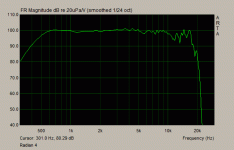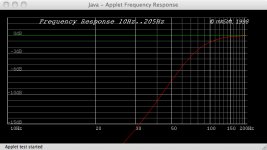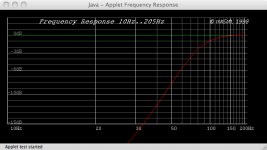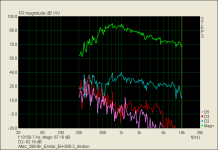Gee, don't you wish that had a better off-axis response?
lol yeah, its an amazing driver to bad its expensive
I already own the Neopro5i so its just double that cost. I will own them at some point, the measurements are just sick and I use the DCX so LR24 is real easy for me.
Last edited:
btw, the neopro5i is extremely flat too....Ribbons are easy to design with since there isnt much that needs to be done.
Well, it remains to be seen what will actually mate well to a TD15H as part of a 2-way.
We really need the on and off-axis response curves to know for sure, but they do look like good candidates.
Here are the TD15X measurements.
AE Speakers TD15X 4ohm (drivervault)
I would use the 12" woofers if we are going up past > 1KHz.
AE Speakers TD15X 4ohm (drivervault)
I would use the 12" woofers if we are going up past > 1KHz.
Here are the TD15X measurements.
AE Speakers TD15X 4ohm (drivervault)
I would use the 12" woofers if we are going up past > 1KHz.
I have been considering the TD15H and I just might have to buy one and see how it really fares. Very impressive woofer.
I have been considering the TD15H and I just might have to buy one and see how it really fares. Very impressive woofer.
Please do, I do not know anyone that has that one yet.
I know about the TD12M, TD12S, TD15X, TD15M but no one has the TD15H. I think it would be a great woofer in a full range design.
Better yet, maybe the TD18H ?
Please do, I do not know anyone that has that one yet.
I know about the TD12M, TD12S, TD15X, TD15M but no one has the TD15H. I think it would be a great woofer in a full range design.
Better yet, maybe the TD18H ?
I misspoke. Looking over my emails John had recommended the TD15X.
does anyone here have full range graphs for TD15M? - considering one for a Karlson "X-style" two-way
An externally hosted image should be here but it was not working when we last tested it.
Fred, closest you may get is Brandon's tests of the 12M and 15X and some mental extrapolation between them. Same cone shape, different coils and surrounds between the M and others in the same size.
Drivervault
Drivervault
I have TD15H's (and TD15M's too), and will start building later this month. The project was at first going to be a 2-way with the TD15M's and GPA 288-16H alnico drivers on Azurahorn AH-425's, but it has since grown into a much larger project.
The original idea was to put the TD15M's in large bass reflex cabinets, but I wasn't confident that I could get the bass response shape right, and didn't want to build a whole bunch of cabinets trying to dial it in. I decided instead to put the TD15M's in small sealed enclosures (about 2 cf), and let them roll of naturally at about 80 Hz. The bottom octaves for each channel will be handled by a TD15H in a 5 cf enclosure with two PR15-700 passive radiators from AE. These bass cabinets will be driven by their own plate amps, allowing me to tailor the LF response shape by turning knobs. I would like to overlap the drivers a bit, using the upper part to fill in the baffle step area (about 200 Hz).
After measuring the response of both GPA 288-16H and Radian PB745 drivers on the Azurahorn, I decided to use the Radians. The PB745's are beautifully flat to 10 kHz, then they drop off abruptly, returning with ragged peaks from about 12 to 18 kHz. I will probably run them to about 8 kHz, and use my Aurum Cantus G3 ribbons the rest of the way up, unless the Radians sound better on their own.
With two 15" drivers and two 15" passive radiators, a large-format horn and a ribbon to top it off, this isn't going to be an inconspicuous speaker system. We'll see how the WAF part works out...
Gary Dahl
The original idea was to put the TD15M's in large bass reflex cabinets, but I wasn't confident that I could get the bass response shape right, and didn't want to build a whole bunch of cabinets trying to dial it in. I decided instead to put the TD15M's in small sealed enclosures (about 2 cf), and let them roll of naturally at about 80 Hz. The bottom octaves for each channel will be handled by a TD15H in a 5 cf enclosure with two PR15-700 passive radiators from AE. These bass cabinets will be driven by their own plate amps, allowing me to tailor the LF response shape by turning knobs. I would like to overlap the drivers a bit, using the upper part to fill in the baffle step area (about 200 Hz).
After measuring the response of both GPA 288-16H and Radian PB745 drivers on the Azurahorn, I decided to use the Radians. The PB745's are beautifully flat to 10 kHz, then they drop off abruptly, returning with ragged peaks from about 12 to 18 kHz. I will probably run them to about 8 kHz, and use my Aurum Cantus G3 ribbons the rest of the way up, unless the Radians sound better on their own.
With two 15" drivers and two 15" passive radiators, a large-format horn and a ribbon to top it off, this isn't going to be an inconspicuous speaker system. We'll see how the WAF part works out...
Gary Dahl
Last edited:
..this isn't going to be an inconspicuous speaker system. We'll see how the WAF part works out...
Gary Dahl
*costly* (..one way or another.)
I have TD15H's (and TD15M's too), and will start building later this month. The project was at first going to be a 2-way with the TD15M's and GPA 288-16H alnico drivers on Azurahorn AH-425's, but it has since grown into a much larger project.
The original idea was to put the TD15M's in large bass reflex cabinets, but I wasn't confident that I could get the bass response shape right, and didn't want to build a whole bunch of cabinets trying to dial it in. I decided instead to put the TD15M's in small sealed enclosures (about 2 cf), and let them roll of naturally at about 80 Hz. The bottom octaves for each channel will be handled by a TD15H in a 5 cf enclosure with two PR15-700 passive radiators from AE. These bass cabinets will be driven by their own plate amps, allowing me to tailor the LF response shape by turning knobs. I would like to overlap the drivers a bit, using the upper part to fill in the baffle step area (about 200 Hz).
After measuring the response of both GPA 288-16H and Radian PB745 drivers on the Azurahorn, I decided to use the Radians. The PB745's are beautifully flat to 10 kHz, then they drop off abruptly, returning with ragged peaks from about 12 to 18 kHz. I will probably run them to about 8 kHz, and use my Aurum Cantus G3 ribbons the rest of the way up, unless the Radians sound better on their own.
With two 15" drivers and two 15" passive radiators, a large-format horn and a ribbon to top it off, this isn't going to be an inconspicuous speaker system. We'll see how the WAF part works out...
Gary Dahl
Very nice, Im checking out the Radian PB745 so thanks for that one! What horn are you using for it again? I have BMS CDs but someone posted that the Radians have a much smoother sound.
How does the TD15M roll off naturally to 80Hz though? Its not that different then the TD12M and the TD12M won't rolloff below 150 according to WinISD. I will have to check the difference. The Xmax on the "M" series tells me its not meant to go to low.
Last edited:
Very nice, Im checking out the Radian PB745 so thanks for that one! What horn are you using for it again? I have BMS CDs but someone posted that the Radians have a much smoother sound.
The horn is the AH-425 from Azurahorn, a design commissioned by Lynn Olson. This model doesn't appear on the Azurahorn website; one must ask about it. Overall diameter is about 16.25", length is about 10.25". The response curve is attached.
Measurements also showed that the distortion spectrum of the Radian was much cleaner than the 288, so I believe what others have said about it having a smoother sound.
More about the TD12M later...
Gary Dahl
Attachments
More about the TD12M later...
Oops, I meant the TD15M. Here are a couple of examples:
An 86.8-liter enclosure will result in a Q of 0.707. No peak, F3 is at 74.35 Hz.
A 75-liter enclosure will result in a Q of 0.75. Peak is 0.05 dB, and F3 is 74.61 Hz.
Gary Dahl
Attachments
The horn is the AH-425 ,,,,,snip,,,,, The response curve is attached.
Measurements also showed that the distortion spectrum of the Radian was much cleaner than the 288, so I believe what others have said about it having a smoother sound.
snip,,,,,snip
Gary Dahl
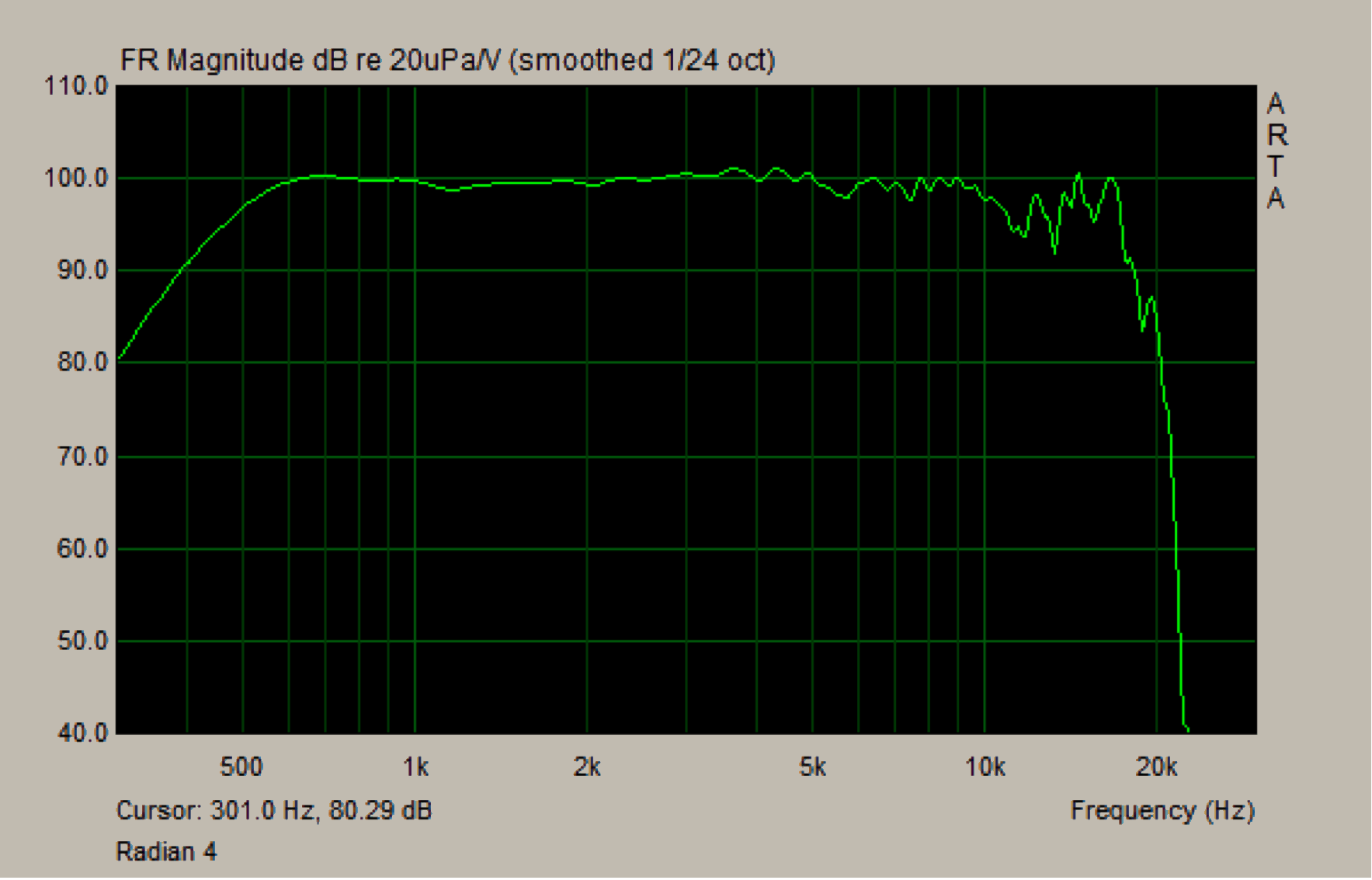
Say Gary, is the above FR plot made with one of your drivers ?
If so, would you please post the distortion measurements ( STEPS, I suppose ) of the Radian on that AH-425 . Thanks !
Here's a distortion measurement of an Altec 288-8K on an Emilar Radial .
- This is taken at a home listening level of @ 80 db . The scale shown is merely relative .
- I consider this result as pretty low distortion and it sounds that way.
- Here's the accompanying FR of that same combo .
- It has passive EQ applied to give me a custom HF contour .
- The 40 db vertical scale, with 1/24 smoothing applied, is very critical look-see at the FR . This is ungated .
- The inset ( 1/3 octave smoothing ) is closer to what it sounds like / ie; very smooth .
- Did you measure your own GPA 288-16H for distortion ?
- Or is this ( distortion ) conclusion based upon a measurement of a 288H belonging to Lynn Olson ( a unit which I consider has a misfitted diaphragm ) .
- ( ie; The first one Augerpro measured ).
<> cheers EarlK
PS: I can't argue with the linearity of the displayed Radian / though I wish you guys would post FR pics in a more demanding linear scale ( such as 50 db )
Attachments
I measured my own GPA 288-16H drivers, plus two others. None of these were Lynn's. I measured FR using ARTA. Haven't started using STEPS yet. I observed distortion components directly by playing sine waves of various frequencies and watching the harmonics in the spectrum analyzer window. All four GPA drivers were different. I suspect that the performance of the 288 depends upon the centering of the diaphragm, and that the paper-shim method allows for some variability.
The two Radian 745's, however, do belong to Lynn. He hasn't seen them yet. FR was nearly identical between the two drivers, and I was happier with what I saw in the distortion spectra.
This summer I hope to learn more about using ARTA, and get started with STEPS.
Gary Dahl
The two Radian 745's, however, do belong to Lynn. He hasn't seen them yet. FR was nearly identical between the two drivers, and I was happier with what I saw in the distortion spectra.
This summer I hope to learn more about using ARTA, and get started with STEPS.
Gary Dahl
GPA-604's...
I have posted here and elsewhere as to their merits as I own a pair of the series III with the UREI style horn. I also tried them in 6 different enclosures including sealed, vented, open baffle and MLTL. A turn-key crossover is available from Selah Audio that sounds wonderful. A small sealed box ~2 cubic feet will give you 80hz beyond 20khz...and a 9.5-10.5 cubic ft MLTL will give you a full range 2 way and there are many stops in between with respect to box size. The open baffle is actually the most transparent and astonishing, but is (sort of) SPL limited and lacking in low end. A small sealed box with subs or the giant box are probably the best way to go. Right now mine are in a ~110l vented box where I was shooting for an F6 of ~40hz...
My only gripe about the 604 is vertical dispersion...which is only bothersome when I'm in the next room or walking around. It's a small quibble really.
Best,
I have posted here and elsewhere as to their merits as I own a pair of the series III with the UREI style horn. I also tried them in 6 different enclosures including sealed, vented, open baffle and MLTL. A turn-key crossover is available from Selah Audio that sounds wonderful. A small sealed box ~2 cubic feet will give you 80hz beyond 20khz...and a 9.5-10.5 cubic ft MLTL will give you a full range 2 way and there are many stops in between with respect to box size. The open baffle is actually the most transparent and astonishing, but is (sort of) SPL limited and lacking in low end. A small sealed box with subs or the giant box are probably the best way to go. Right now mine are in a ~110l vented box where I was shooting for an F6 of ~40hz...
My only gripe about the 604 is vertical dispersion...which is only bothersome when I'm in the next room or walking around. It's a small quibble really.
Best,
Last edited:
- Status
- This old topic is closed. If you want to reopen this topic, contact a moderator using the "Report Post" button.
- Home
- Loudspeakers
- Multi-Way
- Large format simple two way TD15M w/TPL-150H or GPA604?
